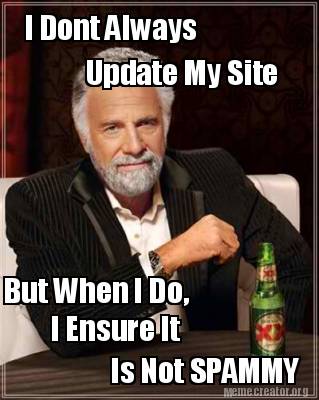It is official, after months of speculation, Penguin 3.0 has landed. And while we aren’t really seeing much change to the SERPs just yet, we know that the update is aimed primarily at ‘combating spam’ (like all of them…) and a lot of webmasters and SEOs are probably saying their prayers (though it’s not bad news for everyone) right now. Some reports suggest the update is still being rolled out, so we’re all waiting with bated breath to see whether our rankings will ultimately go up or down.
History Repeating Itself
Sound familiar? It should: we’ve been here many times before with previous iterations of Penguin, as well as Panda and even ‘Pigeon’ to some extent. Google changing their algorithms is nothing new, and yet we still seem to run around like headless chickens every time it happens. Why aren’t we better prepared for these events yet?
Sure, the precise nature of the change is always going to be unpredictable – but by now we should have caught on to the general gist of what’s happening at least. Geez, Penguin alone has been updated 6 times now and it’s safe to say that they’ve all done generally the same thing. Broadly, Panda targets pages that are ‘low quality’, perhaps displaying thin content, while Penguin is targeted at spam and link manipulation.

How to Survive Any Update (With Steps)
What this means is that we should by now know how to protect ourselves broadly from updates and there should be no real reason to get all anxious every time a new update rolls out. We should all have learned from our mistakes by now – but just in case – here is your survival guide for surviving any and all future changes:
Step 1: Don’t Panic and Don’t Over-Correct
Step number one is to not panic and certainly not to over-correct. For those who didn’t watch How I Met Your Mother, an over-correction is what happens when you veer too far in the other direction in order to make up for a perceived mistake. If you dated someone who was overly chatty in the past for example, an over-correction would be dating the shyest person in the world who never talks.
This happens to SEOs and webmasters a lot during algorithm updates. You know: you get penalized for using the same anchor text in your inbound links repeatedly, so you over-correct by making sure that every single inbound link uses different text. Maybe Panda penalized you for keyword stuffing, so you removed any trace of any keywords anywhere on your site.
What you have to remember is that Google has no problem with any type of inbound link. Their argument is with webmasters using manipulative and spammy strategies and to find that, they look for behavior patterns. If you over-correct then this will look just as suspicious as what you were doing before, or at best it’s just going to dilute your SEO so much as to render it ineffective.
Promote your site in a genuine, natural and organic way and you will be safe.

Step 2: Read, Learn, and Check Your Stats
While it’s easy to get angry and personally offended by Google’s updates, it’s actually more constructive to look at them in a different way. See this as a free consultation/feedback from Google themselves, and heed their advice. If your traffic has taken a hit, you know you were doing something wrong. If it went up, then you have been doing well. Pay close attention to your stats and keep a log of what you’ve been doing lately that might have contributed to them.
Meanwhile, you should also make sure to scour the web for any updates you can find. This way you can start to build an accurate picture of what’s actually happened and to correlate what you’re seeing with what other site owners are seeing around the web.
Think it’s your use of Google’s Disavow Tool that helped you recover since the last Penguin update? That it may be, but any links you removed after September 15 won’t have been taken into consideration, so those ones shouldn’t factor into your post-game analysis.
Try to create an accurate picture of what’s happened to your site using all the information available to you. That way you can best decide what to keep doing and what to stop doing.
Step 3: Don’t Rest on Your Laurels
As mentioned, Penguin 3.0 has actually been good news for many sites who have seen their rankings improve after seeing the error of their ways. But just because fate has been kind to you this time, that doesn’t mean you can rest on your laurels.
The same analysis is important for those who have been affected positively as well as those who have been hit. It is possible some of your SEO strategies still aren’t favored by Google and if you don’t deal with them now, they might come out of the woodwork later on. Otherwise, it’s just a good idea to learn why you’ve been successful so that you can do even more of it. Now is still the ideal time to take stock and get a bit reflective.
Step 4: Step Into Action
Penguin ‘reassess’ the changes it made last time with each new update. So if you’ve seen a dip in traffic, you then need to start doing everything you can to undo the processes that landed you in trouble in the first place. Just remember it won’t be until the next update rolls out that you’ll find out whether what you did was enough.
So once you’ve assessed the damage and done your research, the next step is to create an action plan and start following it. Sure, you can moan and you can whine about how unfair this all is…but it is the people who just quietly getting on with it stand the best chance of recovery. Put in the effort now and you can rise from the ashes like a fiery phoenix (phoenix would be a bad ass name for an update, FWIW).

Step 5: Remember Other Online Marketing Strategies
Another way to fortify yourself against algorithm updates is to make sure you aren’t relying 100% on SEO in the first place. And this also happens to be the best way to survive while your rankings are lower than normal.
In other words, you might have lost some traffic from Google, but you should still have a mailing list, a Facebook page, a Twitter account, a Pinterest account, a Google+ account, and all of those things can drive plenty of visitors and paying customers to your site. And seeing as Google is increasingly incorporating social indicators into their algorithms (especially from Google+), we can probably assume this is going to help our chances in the next update too.
Step 6: Serve the Audience
First and foremost though, the secret to surviving any Google update is to make serving your audience your priority. Deliver quality to your viewers and do it in an unobtrusive way and you will have aligned your goals with those of Google.
Ultimately, Google want people to come to their search engine and to enjoy using it. That means they want people to find high quality, relevant content. If that describes your site, then you have nothing to fear.

We learned this lesson when Google first unveiled Panda in 2011 and really we knew it before then as well. It’s time to stop getting in a flap about it!
Featured Image: Tom K Photo via Shutterstock, Meme images created by author.





